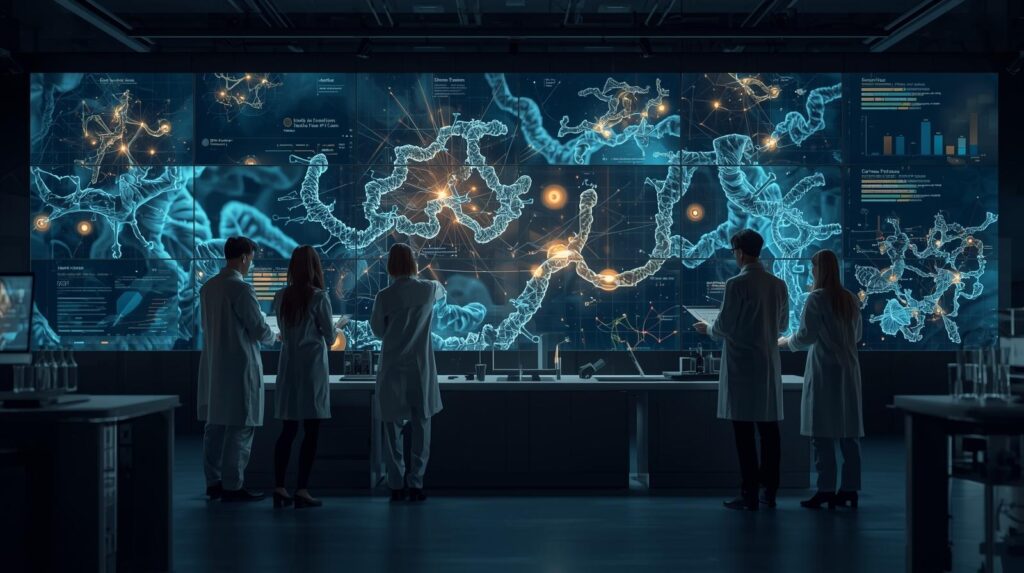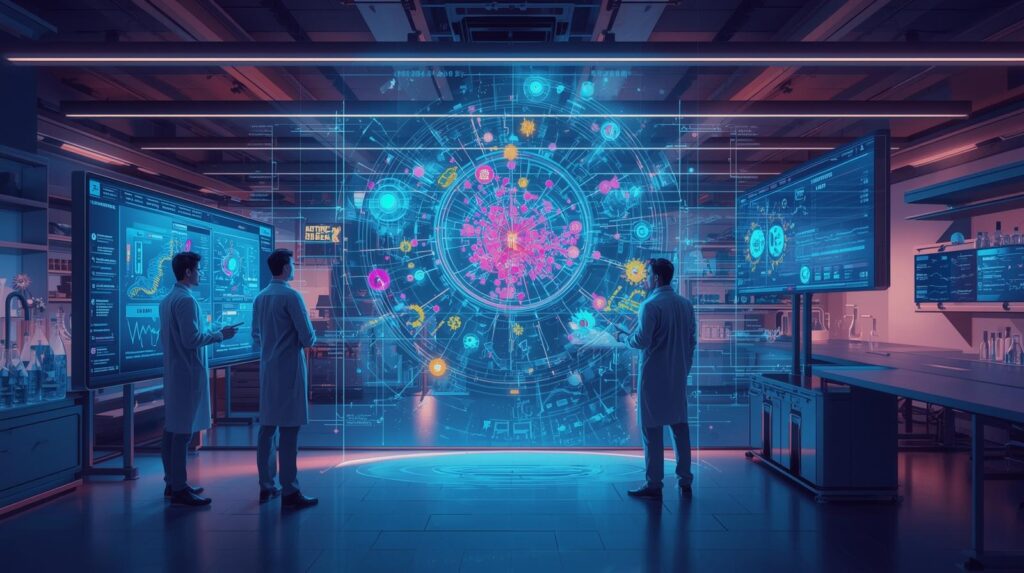
1. Overview
The integration of genomics, proteomics, and pharmacological data is crucial for advancing drug discovery. However, these datasets are often siloed, making it difficult to uncover hidden connections between genes, proteins, and drugs. This project proposes the development of an AI-powered knowledge graph that connects gene-protein-drug interactions and leverages machine learning for predicting novel drug candidates. By integrating open-access biological repositories and applying graph-based AI techniques, the system will serve as a computational engine for drug repurposing and discovery.
2. Problem Statement
Traditional drug discovery is expensive, time-consuming, and has a high failure rate. The challenge lies in connecting molecular mechanisms with therapeutic interventions in a scalable way. Current methods lack the ability to integrate multi-omics data with pharmacological knowledge in a structured, queryable framework.
3. Objectives
- Build a comprehensive knowledge graph of gene-protein-drug interactions from public biological and pharmacological databases.
- Develop graph-based AI algorithms to predict new drug candidates and repurposing opportunities.
- Enable query-driven exploration of biological relationships for researchers and clinicians.
- Provide an explainable AI framework for validating drug predictions.
4. Research Questions
- How can multi-omics and drug interaction data be integrated into a single knowledge graph?
- Which AI techniques (Graph Neural Networks, embeddings, etc.) are best suited for predicting novel drug-disease associations?
- How can explainability be preserved in AI-driven drug predictions?
- Can the model identify repurposing opportunities for FDA-approved drugs?

5. Methodology
5.1 Data Sources
- Genomic & Proteomic: NCBI GEO, UniProt, ENCODE
- Drug & Pharmacological: DrugBank, ChEMBL, PubChem, FDA Open Data
- Disease Associations: DisGeNET, OMIM, ClinicalTrials.gov
5.2 Data Processing
- Entity extraction: genes, proteins, drugs, diseases.
- Relationship mapping: gene–protein, protein–drug, drug–disease.
- Ontology alignment with UMLS and MeSH for semantic consistency.
5.3 Knowledge Graph Construction
- Graph database (Neo4j or TigerGraph).
- Use RDF and OWL for semantic representation.
- Standardize identifiers (HGNC for genes, UniProt IDs for proteins, DrugBank IDs for drugs).
5.4 AI/ML Models
- Graph Embeddings: Node2Vec, DeepWalk.
- Graph Neural Networks (GNNs): GCN, GraphSAGE for link prediction.
- Multi-modal learning to integrate omics and drug data.
5.5 Validation
- Cross-validation with known drug-disease associations.
- Benchmarking against curated gold-standard datasets (DrugBank, ClinicalTrials).
- Collaboration with domain experts for biological plausibility.
6. Technical Approach
- Backend: Neo4j for graph storage and queries.
- AI Models: PyTorch Geometric for GNN implementation.
- Pipeline: ETL scripts for continuous data ingestion.
- Interface: Web-based dashboard for interactive graph visualization (D3.js, Cytoscape).

7. Expected Outcomes
- A biological-pharmacological knowledge graph covering genes, proteins, and drugs.
- AI models capable of predicting new drug candidates.
- A visual exploration tool for researchers to navigate the graph.
- Open-access APIs for integration into external research tools.
8. Innovation
- Combines multi-omics and pharmacological datasets in a single unified graph.
- Applies graph neural networks for novel drug prediction.
- Prioritizes drug repurposing opportunities, reducing cost and time in discovery.
- Integrates explainable AI to ensure biological interpretability.
9. Implementation Roadmap
- Phase 1 (0–6 months): Data collection, cleaning, and ontology alignment.
- Phase 2 (6–12 months): Knowledge graph construction and initial AI models.
- Phase 3 (12–18 months): Advanced GNN models, validation, and web-based dashboard deployment.
10. Use Cases
- Drug Repurposing: Identify existing drugs that can target new diseases.
- Biomarker-Drug Association: Link discovered biomarkers with candidate therapies.
- Gene-Target Discovery: Predict which proteins are potential therapeutic targets.
- Clinical Decision Support: Provide insights for personalized medicine.
11. Potential Challenges
- Data heterogeneity and missing values.
- Computational complexity of large-scale graphs.
- Ensuring explainability in AI-driven predictions.
- Regulatory and ethical considerations in drug prediction.

12. Ethical Considerations
- Ensure patient-related data from repositories is anonymized.
- Avoid biased predictions by balancing dataset representation.
- Provide transparent documentation of AI decision-making.
13. Resources Required
- Infrastructure: Cloud services (Google Cloud, AWS, Azure) with GPU support.
- Human Resources: Bioinformaticians, AI engineers, pharmacologists, software developers.
- Software: Neo4j, PyTorch Geometric, Cytoscape, Bioconductor.
14. Team Composition
- Project Lead: Expert in computational biology.
- AI/ML Specialists: Graph neural networks and machine learning.
- Data Engineers: Data preprocessing and ETL pipelines.
- Domain Experts: Molecular biologists, pharmacologists.
- Software Developers: Dashboard and API development.
15. Timeline
- Total: 18 months
- Months 1–6: Data integration & ontology design.
- Months 7–12: Graph construction & baseline models.
- Months 13–18: Advanced AI, validation, and system deployment.
16. Budget Estimate
- Personnel: $300,000 (18 months).
- Cloud Infrastructure: $50,000.
- Software Licenses & Tools: $20,000.
- Validation & Expert Review: $30,000.
- Total Estimated Budget: $400,000
17. Expected Impact
- Accelerated drug discovery with reduced cost and time.
- Personalized medicine enabled by linking molecular profiles to drugs.
- Open science contribution through APIs and datasets.
- Cross-disciplinary innovation at the intersection of AI, systems biology, and pharmacology.
18. References & Data Sources
- NCBI GEO, UniProt, ENCODE, TCGA.
- DrugBank, ChEMBL, PubChem, FDA Open Data.
- DisGeNET, OMIM, ClinicalTrials.gov.
- Relevant literature on GNNs in drug discovery (2020–2025).
